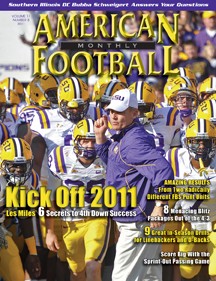AMERICAN FOOTBALL MONTHLY THE #1 RESOURCE FOR FOOTBALL COACHES
Article CategoriesAFM Magazine
|
Zone Blitzing Out of the 4-3 Defense – Various combinations of zone blitzes and their disguises can be effective against any offense.by: Luke CutkompDefensive Coordinator Aurora University (IL) © More from this issue Zone blitzing has been around for a number of years. This scheme has evolved with the different offenses we see today. You may bring multiple backers, drop ends into coverage, play different coverages behind the blitz, and twist defensive linemen within the zone blitz, but the bottom line is that zone blitzing allows the defense to apply pressure in the run and pass game without having to play man coverage. A major part of a successful zone blitz package is disguise. We spend a lot of time disguising our coverage. Our pre-snap look should be the same no matter what the call. Dummy counts can affect your disguise. Simulating dummy counts during practice is helpful in preparing for them. Our base alignment is shown in Diagram 1.
| 
|
Subscribe now to start receiving our monthly magazine PLUS get INSTANT unlimited access to over 4000 pages of 100 percent football coaching information, ONLY available at AmericanFootballMonthly.com! | |||
NEED PASSWORD HELP |





